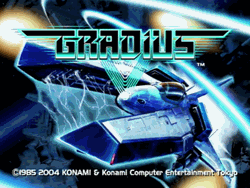 Let us consider the exact ways you may fight your way to the ending of Gradius V.
Let us consider the exact ways you may fight your way to the ending of Gradius V.
Gradius is a shoot ‘em up title that originated in the arcades, but gradually migrated to the home consoles (and the PSP, for some reason). The last release in the franchise was the poorly titled Gradius Rebirth is 2008. But prior to the franchise’s inglorious end, Gradius was one of those titles you would always expect to see at least once a console generation, often attempting to showcase the upgrades and benefits of the latest graphical hardware. Look how many dots there can be on the screen now! Ignore the slowdown! You’re going to love it! In short, Gradius was once a franchise that you could presume everyone had played.
But you’ll be forgiven for not remembering the intricacies of your typical Gradius adventure, so a little reminder will be allowed. Gradius showcases what may be one of the most complicated powerup systems to originate in the 80s. Unlike a Mario or Mega Man that might find a random “pickup” and instantly gain fire blasts or weapon energy, all of Gradius’s powerups contribute to a sort of “powerup purchase” display. At one end of the powerup scale, you have some basic items like Speed Up or Missiles. There at the end of the gauge are such musts as Shield and Options (and, to further elaborate for those unfamiliar, an “option” is a little glowy orb that effectively doubles your firepower. It is called an option because who the hell knows). This means that every single powerup presents not just an advantage over your enemies, but an opportunity for consideration and decision. Do you go for the “easy” powerups immediately, and stockpile speed and offensive options out of the gate? Or do you perhaps hamper your own abilities in pursuit of a more powerful option or shield? All of these opportunities are going to help you live longer, and it’s very important to consider exactly what is going to get you through the hectic combat surrounding Planet Gradius.
Come to think of it, though, these decisions are only important if you don’t know the game. If you know what’s coming next, you barely have to think about powerup management.
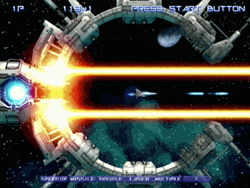 See, the other important thing about Gradius powerups across the franchise is that, in the event of death, you lose everything. Occasionally the Gradius du jour grants you a minor boon like allowing you to reclaim a lost option, but, aside from that, crash the Vic Viper, and you’re back to square one. To say the least, this can be heartbreaking and demoralizing. The big, bad bosses of Gradius have been mass-murderers since day one, and they are rarely accompanied by mooks that will drop powerup capsules. The result? You might start a battle with four options worth of lasers blazing, but take a hit seven seconds into the fight, and you’ll be stuck with a piddly pea shooter. And death is the only option your opponents have! Gradius is not a franchise that has many verbs: it’s a shoot ‘em up that is either shoot or be shot. Aside from just temporarily delaying the Vic Viper, the only option a boss (or any other opponent, for that matter) has is to murder its opponent, so the only way a boss can be challenging is through wholesale wiping you and your powerups off the map. If you don’t know what’s coming, you will die quickly in any given fight.
See, the other important thing about Gradius powerups across the franchise is that, in the event of death, you lose everything. Occasionally the Gradius du jour grants you a minor boon like allowing you to reclaim a lost option, but, aside from that, crash the Vic Viper, and you’re back to square one. To say the least, this can be heartbreaking and demoralizing. The big, bad bosses of Gradius have been mass-murderers since day one, and they are rarely accompanied by mooks that will drop powerup capsules. The result? You might start a battle with four options worth of lasers blazing, but take a hit seven seconds into the fight, and you’ll be stuck with a piddly pea shooter. And death is the only option your opponents have! Gradius is not a franchise that has many verbs: it’s a shoot ‘em up that is either shoot or be shot. Aside from just temporarily delaying the Vic Viper, the only option a boss (or any other opponent, for that matter) has is to murder its opponent, so the only way a boss can be challenging is through wholesale wiping you and your powerups off the map. If you don’t know what’s coming, you will die quickly in any given fight.
But if you know what’s coming, you will survive. And if you survive, you keep your powerups. And thus do the powerful grow more powerful.
Growing stronger the longer you survive is a pretty common situation in games of all shapes and sizes, but it is emphasized to an insane degree in Gradius. It might sting to lose a spread gun in Contra, or drop a power leaf in Mario, but in both of those cases, you’re a mere powerup away from winning back what once was lost. In Gradius, you could spend an entire two levels amassing your arsenal, but you’ll still lose it all to an erratically positioned volcano. Got a shield that takes five hits? That’s super, but it’ll be gone in one “hit” if you’re fighting a boss with a particularly enduring laser. Sorry! But the other side of the coin is that it may take you two levels to gain all the powerups you need, but you will be appropriately powerful once you’ve amassed your army. Four options quintuple your firepower (editor’s note: take a math class), and extra speed or a spare laser will make a significant difference in how much you can cover the screen. Once you’re at maximum, bosses explode dramatically faster, and that means your survival is all but guaranteed. Ol’ Big Core has a move that assures your death every time? 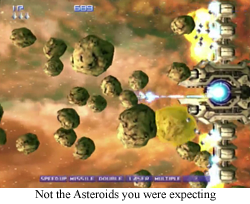 Well, it doesn’t much matter if it can’t survive long enough to use it. Having power in Gradius means you are going to survive significantly longer than your “lesser” peers, and that means you’ll have an easier time acquiring even more power. It means nothing to spend your spare powerup income on a nice, healthy shield insurance policy when you have literally purchased everything else you would ever need.
Well, it doesn’t much matter if it can’t survive long enough to use it. Having power in Gradius means you are going to survive significantly longer than your “lesser” peers, and that means you’ll have an easier time acquiring even more power. It means nothing to spend your spare powerup income on a nice, healthy shield insurance policy when you have literally purchased everything else you would ever need.
But what do you do when you’re powerless? Everyone has to start somewhere, and the theoretical of any videogame is that everyone equally starts from scratch. If these bosses are such murder monsters, you’re inevitably going to be stomped into the ground pretty quickly, and thus be forced to face these titans with the default, “loser” load-out with no hope of gaining any powerups to dig yourself out of that hole. What do you do when you’re so far on the bottom rung, you have nothing left to lose?
And that’s when we peek behind the curtain at the men that made the game.
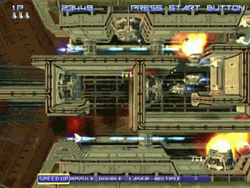 In the arcade era, it was simple: Konami wanted your quarters. Every credit equaled twenty-five (or more!) cents, so you fought to survive because you wanted to save your own precious coinage. In the NES era, things got more dicey, as companies genuinely didn’t seem to know what the home market wanted out of arcade games. As a result (and certainly in Gradius), we saw a number of games that simulated the arcade experience by creating an arbitrary limit on lives/credits. Give or take a Game Genie, this meant the player once again had to preserve life in the name of actually seeing the finale. It didn’t matter if you had lasers for days or just a single missile to your name, you had to survive to make any progress.
In the arcade era, it was simple: Konami wanted your quarters. Every credit equaled twenty-five (or more!) cents, so you fought to survive because you wanted to save your own precious coinage. In the NES era, things got more dicey, as companies genuinely didn’t seem to know what the home market wanted out of arcade games. As a result (and certainly in Gradius), we saw a number of games that simulated the arcade experience by creating an arbitrary limit on lives/credits. Give or take a Game Genie, this meant the player once again had to preserve life in the name of actually seeing the finale. It didn’t matter if you had lasers for days or just a single missile to your name, you had to survive to make any progress.
But things had changed by the time Gradius V rolled around. In 2004, it was a known quantity that, while people enjoy a challenge, the population at large had been spoiled by save files and infinite continue points. If someone had beaten Gradius in 2004, it was a lot more likely they had done it on an emulator with save states than actually piloting the Vic Viper on its original hardware. So how was Konami to create a shoot ‘em up appropriate to the age? Later in the decade, they might have implemented DLC or a subscription model to “earn“ that missile launcher for a mere $3.99. In even just a few years’ time, they might have tied it to a digital account, and you could earn more credits if you would just sign your email on the dotted line. But in 2006? All anyone seemed to treasure was a bullet point on the back of the box that said “over 40 hours of gameplay”. How do you get a gameplay count out of a title that legitimately could be finished in an hour and a half? Konami had an idea!
You are allowed to have unlimited credits in Gradius V. You just have to play the game for seventeen cumulative hours.
And once you have unlimited credits? Whoo boy, you can just ram ol’ Vic up in there, and blast away. You die? You lose your powerups? Who gives a crap! You’re back in business faster than you can say “destroy the core”. Sure, it sucks to see your shields and score go the way of the McDonalds pizza, but you’re still making progress. You’re still saving the galaxy. You’re doing it “wrong”, but there’s no way you could ever do it completely right, so at least you’re doing it. You are denied the finer things in your powerups, but you’re still doing something that gives you those sweet dopamine hits. 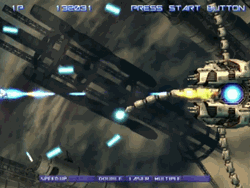 You might not be as successful as those people that have gaming magazines/FAQs, the capability to memorize complicated patterns, or the talent to successfully study youtube videos, but you too can do it! And all it takes is paying Konami their mandated dues by devoting seventeen hours of your life to their game. A small price to pay to beat back the forces of Venom!
You might not be as successful as those people that have gaming magazines/FAQs, the capability to memorize complicated patterns, or the talent to successfully study youtube videos, but you too can do it! And all it takes is paying Konami their mandated dues by devoting seventeen hours of your life to their game. A small price to pay to beat back the forces of Venom!
So that’s the answer for how you beat the most recent, numbered Gradius title. You can either utilize the powerup system to its most significant degree, never experience the slightest accident, and then ride your wave of options straight through to the finish line; or you can “earn” infinite lives through placating the creators at Konami and Treasure by blowing seventeen hours of your precious life unlocking Free Play. How you want to win is up to you!
And if you missed how this entire article is a metaphor for the current state of American economics, please reread the blog for seventeen hours.
FGC #482 Gradius V
- System: Playstation 2, but also available for the Playstation 3. And… uh… guess the Playstation 4 isn’t happening.
- Number of players: Two players! Pew pew with a friend who may or may not be British.
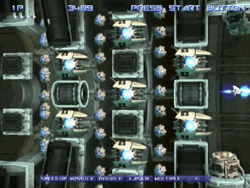 Further problems: “Revival Start” is an available option in Gradius V. This allows you to turn on a more challenging mode wherein you do not instantly respawn, but are revived at a previous location in the level, and all of your opponents are healed/revived with you. While it may be “old school”, this mode is not recommended, as all of the boss creatures have health meters that are not built for this in the least. You just keep crashing Vic Vipers into that problem until it solves itself, and don’t worry about revival start.
Further problems: “Revival Start” is an available option in Gradius V. This allows you to turn on a more challenging mode wherein you do not instantly respawn, but are revived at a previous location in the level, and all of your opponents are healed/revived with you. While it may be “old school”, this mode is not recommended, as all of the boss creatures have health meters that are not built for this in the least. You just keep crashing Vic Vipers into that problem until it solves itself, and don’t worry about revival start.- Maximum Complaints: The number one issue specific to Gradius V is that it seems to revel in focusing the Vic Viper on facing forward, but then compelling the autoscroll to go downwards (okay…) or completely backwards (I hate everything about this). It leads to a number of “gotcha” moments, and, frankly, puts this player in a bit of a bad mood.
- Favorite Level: One of the later levels involves a torrential tide of green acid. While it is an absolute bear to navigate, it is rather fun to see how the screen shifts and “pours” the deadly jelly-for-which-you-are-not-ready all over the screen.
- Did you know? The sheer number of missile options in this game has damaged my brain. I can never decide which direction I want my missiles to go, and, as a result, I always only ever pick powerup loadout #1. At least I understand the basic missile configuration…
- Would I play again: I need a break from Gradius. Seventeen hours is too long to play anything…
What’s next? Random ROB has chosen… Fantasia for the Sega Genesis! Dammit, ROB! So many great Mickey Mouse games for the 16-bit generation, and you chose bloody Fantasia. Dammit! Gah, please look forward to it!
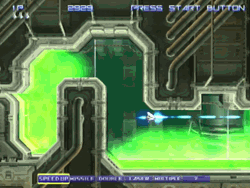
Beware the goo!
[…] the universe in perpetuity. There are two space stages that could be mistaken for lion-based Gradius, and the rest is running around random environments (and, for the record, we have “grass […]
[…] start with comfortable generic areas before ramping up to distinctive, gimmicky challenges (like Gradius), and you have a number of options for upgrades earned by destroying distinct opponents (like […]